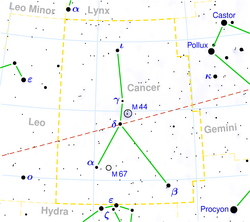Beta Cancri
| Observation data Epoch J2000 Equinox J2000 |
|
|---|---|
| Constellation | Cancer |
| Right ascension | 08h 16m 30.9206s |
| Declination | +09° 11′ 07.961″ |
| Apparent magnitude (V) | 3.50 - 3.58 |
| Characteristics | |
| Spectral type | K4III Ba1 |
| U−B color index | +1.77 |
| B−V color index | +1.48 |
| Astrometry | |
| Radial velocity (Rv) | 22.94 km/s |
| Proper motion (μ) |
RA: −46.80 mas/yr Dec.: −48.65 mas/yr |
| Parallax (π) | 11.23 ± 0.97mas |
| Distance | 290 ± 30 ly (89 ± 8 pc) |
| Absolute magnitude (MV) | −1.218 |
| Details | |
| Radius | 61 R☉ |
| Luminosity | 871 L☉ |
| Surface gravity (log g) | 1.5 cgs |
| Temperature | 3,990 K |
| Metallicity | −0.24 |
| Rotational velocity (v sin i) | 6.9 km/s |
| Other designations | |
| Database references | |
| SIMBAD | data |
β Cancri (Beta Cancri, Altarf) is the brightest star in the zodiacal constellation Cancer. At approximately 290 light years from earth, it has a visual apparent magnitude of +3.5 and absolute magnitude of −1.2. The star is an orange K-type giant, about 61 times the radius of the Sun.
The traditional name Tarf or Al Tarf (anglicized as Altarf), can be translated from Arabic as "end" or "edge".
β Cancri is Barium star, a type of cool giant showing enhanced abundances of Barium. It is also suspected to vary slightly in brightness.
β Cancri is known to have a fourteenth magnitude, red dwarf companion star. From its angular distance of 29 arcseconds, the companion's distance from its parent star is estimated at some 2600 AU, and has an orbital period of 76,000 years.
In a paper published in the journal Astronomy & Astrophysics on May 12, 2014, evidence was presented of a planet orbiting β Cancri. Using radial velocity data from repeated observations of the star, the planet is estimated to have a minimum mass of approximately 7.8 times that of Jupiter, and an orbit of 605 days.
...
Wikipedia

